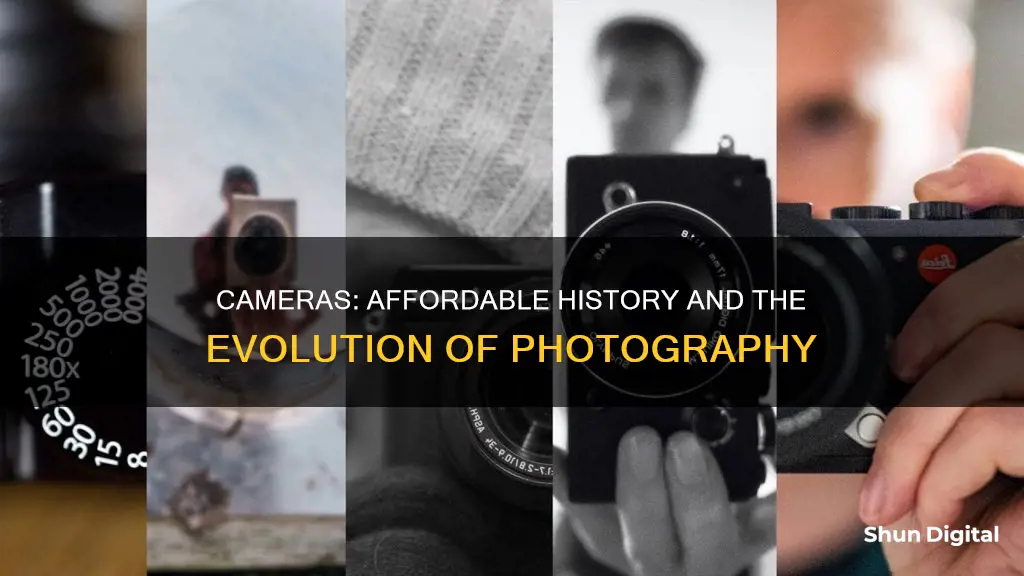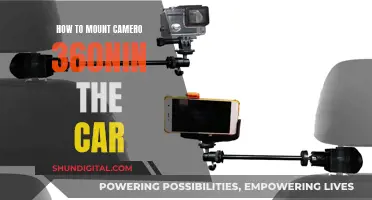
The affordability of cameras has changed over time, with the technology becoming more accessible to the masses in the late 19th and early 20th centuries. Initially, photography was a costly and time-consuming process, requiring specialised equipment and chemicals. However, with advancements in technology, cameras became more affordable and user-friendly.
The first permanent photograph was taken in 1826 by Joseph Nicéphore Niépce, marking the beginning of the photography journey. In 1888, George Eastman introduced the Kodak box camera, pre-loaded with film for 100 exposures. This camera was sent back to the factory for processing and reloading, making photography more convenient. The Kodak Brownie, released in 1900, was even simpler and less expensive, democratising photography and turning it into a leisure activity.
The introduction of 35mm film by Oskar Barnack and Leica in 1913 further revolutionised photography. This allowed any camera manufacturer to adopt the standard and offer their cameras. The Leica I, released in 1925, was the first compact camera with a good lens and the ability to use 35mm film.
The digital camera's history began in the 1960s with NASA's Eugene F. Lally, who conceptualised capturing digital images using a mosaic photosensor. The first actual digital still camera was developed by Eastman Kodak engineer Steven Sasson in 1975. This camera was large and heavy, capturing low-resolution black-and-white images. The first digital camera to go on sale in the US was the Dycam Model 1 in 1990, followed by Apple's QuickTake 100 in 1994, which cost less than $1000.
The camera phone's introduction in 2000 marked a significant shift, integrating video camera technology into mobile devices. Sharp and Samsung were early manufacturers, and by 2003, camera phone sales surpassed digital camera sales. The release of the iPhone in 2007 further propelled the smartphone era, with continuous improvements in camera quality and the ability to instantly share photos on social media.
| Characteristics | Values |
|---|---|
| Date | 1975 |
| Inventor | Steven Sasson |
| Company | Eastman Kodak |
| Size | Size of a toaster |
| Weight | 4 kilograms |
| Image colour | Black-and-white |
| Resolution | 0.01 megapixels |
| Shutter speed | 23 seconds |
| Power source | 16 batteries |
| Storage medium | Digital cassette tape |
What You'll Learn
- The first affordable camera was the Kodak Brownie, released in 1900
- The first digital camera was developed by Steven Sasson in 1975
- The first digital camera sold in the US was the 1990 Dycam Model 1
- The first camera phone was the Kyocera Visual Phone VP-210, released in 1999
- The first mass-produced colour film was Kodachrome, introduced in 1935

The first affordable camera was the Kodak Brownie, released in 1900
The Brownie was a basic camera with simple controls and a convex-concave lens that took 2+1⁄4-inch square pictures on No. 117 roll film. Its simple design meant that although it was initially marketed towards children, it soon achieved broader appeal as people realised that the Brownie could produce very good results under the right conditions.
The popularity of the Brownie meant that many iconic shots were taken using the camera. For example, on 15 April 1912, Bernice Palmer used a Kodak Brownie 2A, Model A to photograph the iceberg that sank the RMS Titanic, as well as survivors hauled aboard the RMS Carpathia. The camera was also taken to war by soldiers, though by World War I, more compact cameras such as the Kodak Vest Pocket Camera and Kodak's Autographic Camera were more frequently used.
The Brownie camera spawned many varieties, such as a Boy Scout edition in the 1930s, and continued to be popular until the 1960s. The last official Brownie camera made was the Brownie II Camera, a 110 cartridge film model produced in Brazil for one year, 1986.
Downsizing Raw Camera Files: Techniques for Efficient Storage
You may want to see also

The first digital camera was developed by Steven Sasson in 1975
The history of the camera is a long and fascinating one, with many innovations and inventors contributing to its development over the centuries. One of the most significant milestones in this journey was the creation of the first digital camera by Steven Sasson in 1975.
Sasson, an American electrical engineer, developed the world's first portable, self-contained digital camera while working at Eastman Kodak Company. His creation marked a pivotal moment in the evolution of photography, paving the way for the digital revolution that would transform how we capture and share images.
Sasson's camera was a remarkable feat of engineering. Weighing in at 8 pounds (3.6 kg), it utilised a Fairchild CCD image sensor with a resolution of 100 x 100 pixels (0.01 megapixels). The images were recorded in black and white onto a compact cassette tape, a process that took 23 seconds per image. This prototype camera was a technical marvel for its time, setting the stage for the digital photography era.
Sasson's invention was not immediately embraced by Kodak, who held a lucrative monopoly in the film photography market. Despite this initial reluctance, Sasson's work laid the foundation for future developments, and he was recognised for his contributions with the National Medal of Technology and Innovation awarded by President Barack Obama in 2009.
The story of the first digital camera is a testament to human ingenuity and our relentless pursuit of innovation. It serves as a reminder that even the most groundbreaking technologies have humble beginnings, evolving over time to shape our world in profound ways.
The Ultimate Battery Backup Plan for Photographers
You may want to see also

The first digital camera sold in the US was the 1990 Dycam Model 1
The history of cameras is defined by a series of world-changing inventions and discoveries. The first permanent photograph was invented more than a century before portable cameras were available for everyone to buy, but once technology caught up, cameras became an essential part of everyday life.
The first camera made available to the public was Joseph Nicéphore Niépce's camera obscura, which he used to create the first-ever photograph in 1826. However, this was not a commercial product.
The first commercially available camera was the Daguerreotype, created by Niépce's partner Louis Daguerre in 1839. This was a significant improvement on Niépce's camera, but it was still not accessible to everyone.
The first camera to use plates from the shelf was produced by Alphonse Giroux in 1839. This camera had an exposure time of 5 to 30 minutes and cost around $7,000 in today's money. It was accessible, but not cheap.
The first camera to be widely adopted by the masses was the Kodak Brownie, released in 1900. This camera was simple and inexpensive, allowing everyone to record their memories.
The history of cameras has been a story of continuous innovation and improving accessibility. From the camera obscura of the 16th century to the Dycam Model 1 of the 1990s, cameras have become increasingly portable, affordable, and capable of capturing high-quality images.
Home Camera Service Charges: What's the Deal?
You may want to see also

The first camera phone was the Kyocera Visual Phone VP-210, released in 1999
The history of cameras is defined by a series of world-changing inventions and discoveries that have transformed the way we see the world. The first permanent photograph was invented more than a century before portable cameras were available for everyone to buy, but once technology caught up, cameras became an essential part of everyday life.
The first camera phone was the Kyocera Visual Phone VP-210, released in Japan in May 1999. It was considered a ""revolutionary"" device at the time of its launch and was the first commercially available mobile camera phone. The phone was developed by the Kyocera Corporation, an electronics manufacturer based in Kyoto, Japan, between 1997 and 1999.
The Kyocera Visual Phone VP-210 featured a forward-facing camera, pre-dating the popularity of selfies in the early 2000s. The camera had a resolution of 0.11 megapixels and could store up to 20 JPEG images. While the camera could only send up to two images per second over Japan's Personal Handy-phone System (PHS) cellular network, it could also convey the stored images by email. The phone even had its own integrated stand for taking pictures of oneself.
The Kyocera Visual Phone VP-210 retailed for 40,000 yen in Japan, which was approximately $325 in 1999 or about $521 in 2021. This price point made the device accessible to consumers, marking a significant step towards making cameras affordable for the general public.
Choosing the Right Camera Profile for Your RAW Photos
You may want to see also

The first mass-produced colour film was Kodachrome, introduced in 1935
The history of the camera is a long and fascinating one, stretching back centuries before the advent of modern photography. The journey towards making cameras affordable for the masses was a gradual process, marked by numerous technological advancements and innovations. One significant milestone in this journey was the introduction of colour film, with Kodachrome, the first mass-produced colour film, being launched in 1935.
The Advent of Colour Film
Kodachrome, introduced by Eastman Kodak in 1935, was a groundbreaking innovation in the world of photography. It was one of the first successful colour materials, offering vibrant and accurate colour reproduction for both still photography and cinematography. Kodachrome brought colour to the world of photography, allowing people to capture the full spectrum of their surroundings. This was a significant departure from the black-and-white images that had previously dominated the medium.
The Impact of Kodachrome
The launch of Kodachrome in 1935 as a 16mm movie format marked a pivotal moment in the history of colour photography and cinematography. For the first time, photographers and filmmakers had access to a mass-produced colour film that delivered consistent and vibrant results. This opened up new creative possibilities, as colours could now be faithfully captured and reproduced. The world of photography was forever changed, as artists and enthusiasts embraced the new medium.
The Complexities of Processing
One of the unique aspects of Kodachrome was the complexity of its processing requirements. Due to its intricate nature, the film could not be developed by amateur photographers or local photo labs. Instead, it had to be mailed to designated Kodak laboratories for processing, which was initially included in the purchase price. This process-paid arrangement ensured that customers received consistent results, as Kodak technicians were trained to handle the intricate chemistry and machinery required for developing Kodachrome.
The Evolution of Kodachrome
Over the years, Kodachrome underwent several alterations and improvements to enhance its performance and ease of use. In 1936, a year after its initial launch, Kodachrome became available in the 8mm movie format, followed by the introduction of 35mm and 828 formats for still cameras. These expansions made the film more versatile and accessible to a wider range of users. However, as alternative colour films entered the market and digital photography gained traction, Kodachrome's market share began to decline.
The Legacy of Kodachrome
Despite eventually losing its dominant position in the market, Kodachrome left an indelible mark on the world of photography and cinematography. It inspired numerous other colour films and influenced the development of subsequent technologies. Kodachrome's longevity is evident in its 74-year run, with production only ceasing in 2009. Even today, long after its discontinuation, Kodachrome remains revered for its colour accuracy and archival stability, with digital scanning technologies facing challenges in accurately reproducing its unique colour palette.
Charger Lost? Here's How to Power Your Camera
You may want to see also
Frequently asked questions
Cameras became affordable for the average consumer in the late 19th century. In 1888, George Eastman of Kodak manufactured and sold a camera named "Kodak" for $25. The camera used a roll film that allowed for 100 exposures.
The Kodak camera was affordable because it was simple to use and relatively inexpensive. It also offered a unique service where photographers could send the entire camera to the Kodak factory for developing and reloading.
Colour photography became affordable with the launch of Kodachrome film by Kodak in 1935. This was closely followed by Agfacolor by Agfa in 1936 and Kodacolor by Kodak in 1942.
Digital cameras became affordable in the early 1990s with the introduction of the first consumer digital cameras like the Dycam Model 1 in 1990 and the Apple QuickTake 100 in 1994, which cost less than $1000.
The affordability of digital cameras was driven by advancements in technology, such as the development of CCD and CMOS sensors, and competition among manufacturers like Sony, Nikon, Canon, and Apple.







